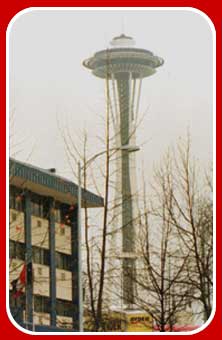| � |
| The
city of Seattle, Washington state, USA was hit by an earthquake
which registered 6.8 on the Richter scale at 10.54 am
(local time) on February 28th 2001. The quake lasted nearly
a minute and was the biggest earthquake in the area for
52 years. A 66 year old woman died of a heart attack during
the quake, and there were 250 people injured, mostly from
falling debris. Overall, Seattle suffered relatively little
damage. The city's buildings shook, but didn't collapse.
The mayor of Seattle said that his city was "very resilient",
and should make a complete recovery. Nevertheless, the
costs of repairing the damage are likely to be more than
$1 billion. |
Seattle's
'Space Needle' was built to handle a 9.1 magnitude earthquake.
|

� Popperfoto/Reuters
|
Jim Stone, a secondary
school Maths teacher was teaching a class when the earthquake
struck. He said, "kids started diving under their desks and
I was under mine in no time. Things fell from the ceiling
and off the walls. When I heard things crashing down I just
yelled, "make sure your legs and feet are under the tables
and you guys over by the window, face towards the room" while
I was seriously hoping that the whole damn building didn't
collapse. The sound was deafening. It was like several freight
trains were rolling through the classroom at once. I can't
tell you how afraid I was".
Seattle lies in the Pacific
Northwest region of the USA, and is used to earthquake activity.
Here, the edge of the dense oceanic Juan de Fuca plate
is sliding under the continental North American plate
on a destructive plate
margin. Tension builds up between these plates
as they jam and snag together. Sometimes this pressure is
released, causing the plates to jolt, sending out shock waves
from the epicentre. Luckily for Seattle residents, the earthquake's
epicentre was 58km south-west of the city, and 48km underground
in solid rock. The depth of the epicentre
helped to soften the effects on the surface.
Older brick buildings
in the historic Pioneer Square area were worst hit. Here,
structural damage may mean that some have to be demolished,
such as the Fenix Underground nightclub. Elsewhere in the
city, some roads buckled, and visitors at the top of the 185m
tall 'Space Needle' felt the building shudder violently. In
addition, the city ferry terminal building was damaged and
a 9m crack appeared in the car park. Flights in and out of
Seattle's airport were delayed following damage to the control
tower, and 17,000 residents were without power for some time.
Businesses in the area will also feel the impact for some
time to come. Many were forced to send their employees home
because of concerns over the safety of offices, shops and
factories.
On average, the area
experiences an earthquake every 30-40 years, but it is still
impossible to predict when the next one may come. To prepare
for earthquakes, most companies take out insurance to cover
any possible losses, but many local residents choose to take
a risk instead. Less than a third of homeowners take out extra
insurance to cover any damage caused by an earthquake. On
the other hand, Seattle city authorities have introduced strict
building codes to ensure that buildings can withstand earthquake
activity. Meanwhile, the city authorities have spent millions
on reinforcing buildings and bridges, and bolting homes to
their foundations. In the future, a new kind of concrete called
'simcon', reinforced with mats made of stainless steel fibre
could even make buildings virtually quake proof. Therefore
whilst the people of Seattle cannot prevent future earthquakes
nor accurately predict them, they can certainly prepare themselves
to minimise the amount of damage to people and property.
|
� |





